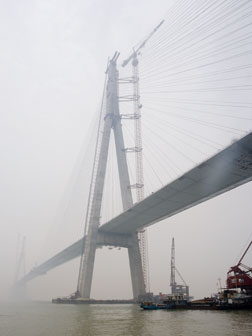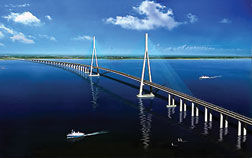 Michael Goodman/ENR |
Sporting the world's longest cable-stayed span, largest piled foundations, second-tallest towers and longest cable, the Sutong Bridge in China's Jiangsu Province will also serve the more mundane purpose of cutting off almost an hour off the crossing of the Yangtze River between the cities of Nantong and Suzhou–currently done only by ferry.
Costing approximately $1 billion, the Sutong Bridge has a 1,088-meter-long main span supported by 114-m-long, 48-m-wide pilecaps that rest on bored piles up to 2.8 m in diameter and sunk into sandy soils as deep as 120 m. Paving work is complete and the bridge is on target to open to traffic in May 2008. The 1,088-m span will replace the current cable-stayed world record holder for length–the Tatara Bridge in Japan with an 890-m main span.
The bridge, only 82 km away from China's 1,385-m-long Jiangyin bridge–the world's fifth-longest suspension crossing–is part of a 32.4-km-long, six-lane highway project that must handle China's booming economic growth. The bridge is designed with a 891-m-wide, 62-m-high navigational clearance, as almost 3,000 ships sail past every day.
 Longest Sutong cable is 577 m, believed to be a recordsetter. |
Building bridges over the Yangtze River has always been challenging, but was especially so for the Sutong Bridge because of the strong currents, poor climate, expansive soils and busy traffic, says Jian Zhao, section chief and a senior engineer for Jiangsu Provincial Communication Dept., the client. "If we did not finish erecting the steel deck before the typhoon season started in July, or if we did not finish the pavement before the winter came, we would miss a year of time," he says. But accomplishing both tasks means the bridge will open a year ahead of the original plan, he adds.
The bridge is located north of Shanghai, 108 km before the river meets the East China Sea. That means it is located in the northern part of the Yangtze River Delta region, which has a marine monsoon subtropical climate. It has an annual average of 120 rainy days, and frequent threats of typhoons and tornados.
The superstructure soars over an S- shaped 6-km-wide stretch of river with waves that often reach up to 3 m high, plus daily tides up to 4 m in height and strong currents, also adding to the site challenges.
|
|
Firm Foundations
The very first design challenge for a design team of the Beijing-based Highway Planning & Design Institute, the Jiangsu Planning & Design Institute and Tonji University, entailed how to build the foundations without drilling 300 m deep into bedrock. The solution was to design massive piles "squeezed" 60 m down to sandy, silty soils.
 Michael Goodman/ENR New bridge must resist typhoons, earthquakes, tides and ship collisions. |
The two 300-m-tall inverted Y-shaped concrete towers, holding steel anchorage boxes, are second only to the Millau Viaduct in France in height by about 43 m. They each are supported by 131 of the 120-m-long cast-in-place bored piles. Each of the two main reinforced concrete pile caps is 114 m x 48 m and 18 m deep. The base of each tower is bordered by 2-m-thick steel caissons filled with concrete.
Protecting bridges from impact damage caused by ships has been a political issue ever since the Jiujiang Bridge located near the city of Guangzhou, collapsed in June. Nine people were killed in the collapse of the single-tower cable-stayed bridge, after a cargo ship hit the tower foundation.
Would the 2-m-thick caissons be strong enough to protect the Sutong Bridge? "The caisson protects the piles in two ways," says Hong Zhang, chief engineer for the general contractor, The Second Navigational Engineering Bureau of China Communications Construction Group. "It absorbs the force from an impact, and also serves as a bumper to stop boats from approaching the piles." He notes that the bridge "was designed to survive impact from a 50,000-ton ship. The Jiujiang Bridge did not have any protection like this."
Setting up a 117-m x 55-m construction platform for boring the piles in the strong currents and wind was not easy. After installing 12 of the original 130 temporary steel pipes, each 60 m long, to support the platform, the contractor apprehensively watched the pipes shaking in the strong current, says Zhang. So the contractor decided to use the 120-m-long permanent boring pipes to support the platform instead of temporary ones. Doing so solved the problem and saved materials and construction time that would have been used in boring the rest of the temporary piles, he says.
|
|
But driving the 120-m-long steel pipe required special technology and attention. The designed vertical deflection requirement on the piles is 1/200, but the contractor was able to maintain a 1/400 ratio. "We set up a self-adjust fixture on a platform to guide the steel pipe," says Zhang.
The bottom plate for each record-breaking concrete pile cap is a steel plate welded on site, while the sides are assembled from prefabricated plates. The accumulated length of welds is estimated to be over 80,000 m. One of the 2-m-thick steel caissons weighs 5,000 tonnes and was lowered to the site as a whole. The other one, weighing 3,050 tonnes, was lowered in sections.
"It was an un-usual stiff load to handle since a relative movement of 10 mm between the adjacent jacking points would cause a load redistribution of 35%, which would quickly lead to a jack overload," says Tao Hongyi, general manager of Dorman Long Technology Ltd. (DLT), the U.K.-based heavy-lifting specialty subcontractor. DLT placed the 3,050-tonne caisson as well as the steel box girders for the steel orthotropic deck...

Post a comment to this article
Report Abusive Comment